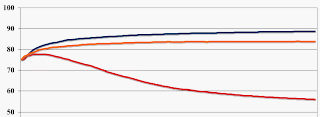
Hiring: The Lake Wobegon Strategy
March 11, 2006
Posted by Peter Norvig, Director, Google Research
You know the Google story: small start-up of highly-skilled programmers in a garage grows into a large international company. But how do you maintain the skill level while roughly doubling in size each year? We rely on the Lake Wobegon Strategy, which says only hire candidates who are above the mean of your current employees. An alternative strategy (popular in the dot-com boom period) is to justify a hire by saying "this candidate is clearly better than at least one of our current employees." The following graph compares the mean employee skill level of two strategies: hire-above-the-mean (or Lake Wobegon) in blue and hire-above-the-min in red. I ran a simulation of 1000 candidates with skill level sampled uniformly from the 0 to 100th percentile (but evaluated by the interview process with noise of ±15%) starting from a core team of 10 employees with mean 75 and min 65. You can see how hire-above-the-min leads to a precipitous drop in skill level; one we've been able to avoid.
Another hiring strategy we use is no hiring manager. Whenever you give project managers responsibility for hiring for their own projects they'll take the best candidate in the pool, even if that candidate is sub-standard for the company, because every manager wants some help for their project rather than no help. That's why we do all hiring at the company level, not the project level. First we decide which candidates are above the hiring threshold, and then we decide what projects they can best contribute to. The orange line in the graph above is a simulation of the hiring-manager strategy, with the same candidates and the same number of hires as the no-hiring-manager strategy in blue. Employees are grouped into pools of random size from 2 to 14 and the hiring manager chooses the best one. We're pleased that these little simulations show our hiring strategy is on top. You can learn more about our hiring and working philosophy.
